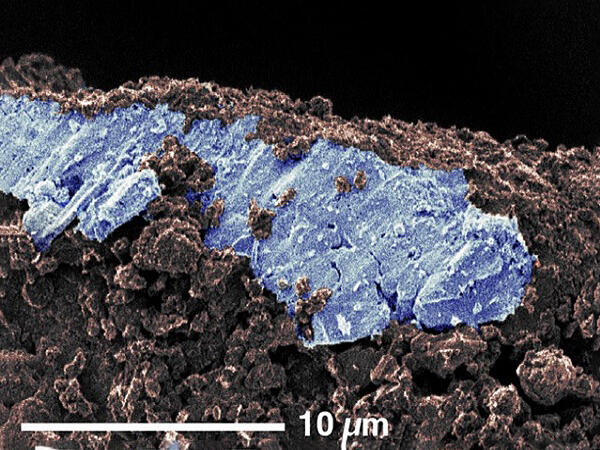Program-Specific Assistant Professor Toru Matsumoto of the Hakubi Center for Advanced Research at Kyoto University, and his colleagues discovered tiny salt crystals in sand grains from asteroid Ryugu, which were collected by the asteroid probe "Hayabusa 2." These are minerals that have precipitated when salt water that filled the Ryugu's parent body was lost due to evaporation or freezing. This discovery will lead to research comparing the water environment of Ryugu with oceanic bodies, such as Enceladus, where salts have been found. The results are published in Nature Astronomy.

Provided by Kyoto University
Matsumoto and his colleagues carefully kept the Ryugu sand completely isolated from the atmosphere and observed its surface using optical and scanning electron microscopes. They then discovered small white veins developing on the sand surface. The observation of minerals that form veins using a transmission electron microscope that can observe structures as small as the nanometer scale revealed that the minerals comprised sodium carbonate, rock salt crystals, and sodium sulfate. A scanning transmission X-ray microscope developed at UVSOR, an extreme ultraviolet light research facility in Okazaki City, Aichi Prefecture, was used for accurately identifying mineral species.
To understand the three-dimensional structure of Ryugu sand and minerals in the sand as a whole, the researchers conducted the nondestructive observation of the sand using X-ray tomography, which was developed at SPring-8.Although Ryugu today is only approximately 800 m across, it is estimated that its parent body, which was once several tens of kilometers across, existed about 4.5 billion years ago, at the beginning of the solar system. Its interior is believed to have been heated by the decay heat of radioactive elements and filled with hot water at <100℃.
The liquid that flowed through the parent body is inferred to be salt water as components extracted with a solvent from the Ryugu sand were rich in sodium, chlorine, and other elements. The salt crystals found are thought to have precipitated in the salt water of the parent body. Because all minerals discovered were salt crystals that are highly soluble in water, it is thought that these crystals could not have precipitated unless the liquid volume was very small and salt concentration was high.
Therefore, Matsumoto and his colleagues hypothesized that after many minerals that make up the Ryugu sand precipitated on the parent body, a phenomenon occurred by which liquid water was lost, causing salt crystals to precipitate. One possible phenomenon responsible for the loss of liquid is salt water evaporation. When fractures connecting the interior of the parent body to outer space on the surface appear, the liquid inside the body is expected to experience reduced pressure and evaporate.
On Earth, when a lake that is left inside a continent dries up, highly saline water is produced, and sodium carbonate and rock salt are precipitated. These are called "evaporites" and might have been formed in the Ryugu's parent body. Another possibility is liquid freezing. As radioactive elements that warmed the parent body become scarce, the body cools and salt water gradually freezes. Cations and anions dissolved in salt water cannot easily incorporate into ice The concentration of the remaining salt water increases as freezing proceeds. Then, salt crystals precipitate from the concentrated salt water. Further, frozen ice eventually sublimates into space by the present day.
No large amounts of liquid are found on the present-day Ryugu, and Ryugu sand grains have never been wet. Therefore, it remains unknown how the liquid water that must have flowed through the parent body is lost.
This study shows for the first time that a liquid loss was caused by evaporation or freezing in the Ryugu's parent body. Sodium carbonate found in the Ryugu sand has not been found in meteorites impacting Earth, and its discovery in the sand of an asteroid was completely unexpected. Meanwhile, salts have been detected on celestial bodies that are thought to have subsurface oceans, such as the dwarf planet Ceres, Jupiter's moon Europa, and Saturn's moon Enceladus.
Various salts reflect the water composition and evolution on celestial bodies. It is expected that salt crystals will provide new clues for comparing similarities and differences between the water environments of Ryugu and other oceanic bodies in the solar system.
Matsumoto said, "Salt minerals found are very sensitive to electron beams and disappear over time when observed under an electron microscope. In terms of handling of Ryugu's minerals, analysis was particularly challenging. By patiently setting up conditions for observation and determining mineral species, we could conduct meaningful research into water evolution in the solar system. When we examined meteorites that reached Earth, we found that salt minerals that dissolve easily in water are quickly changed by weathering on Earth. This discovery was possible only after Hayabusa 2 brought back samples directly from asteroid Ryugu."
This article has been translated by JST with permission from The Science News Ltd. (https://sci-news.co.jp/). Unauthorized reproduction of the article and photographs is prohibited.




